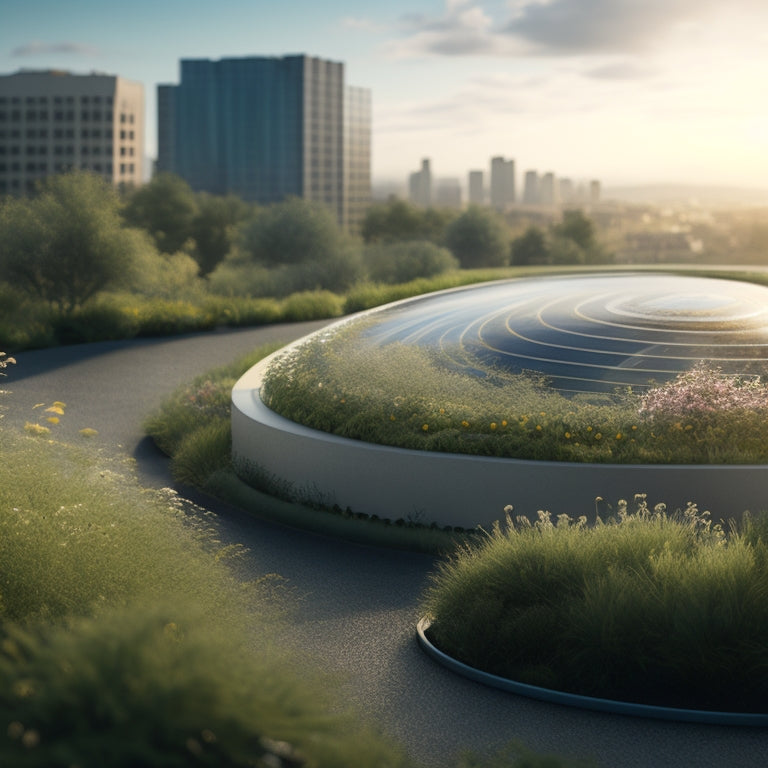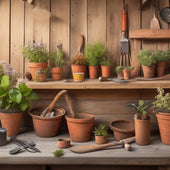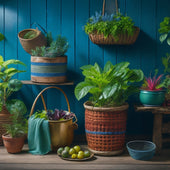
3 Essential Tips for Green Roof Stormwater Management
Share
When designing your green roof, you'll want to prioritize stormwater management to avoid waterlogging, erosion, and structural damage. First, consider the water retention capacity and choose plants that can thrive in both wet and dry conditions. Second, select materials that can withstand varying weather conditions and support water retention and drainage functions. Lastly, implement a regular maintenance routine to guarantee peak performance, including routine inspections, cleaning, and repairs. By following these essential tips, you'll be well on your way to a successful green roof – and there's more to explore to make sure your roof performs at its peak.
Designing for Water Retention
When designing a green roof for stormwater management, you must carefully consider the water retention capacity of the system to guarantee it can handle rainfall events of varying intensities and durations. This involves selecting planting choices that can thrive in wet and dry conditions, as well as incorporating irrigation systems that can adapt to changing weather patterns.
To secure the roof can retain water effectively, you'll need to implement efficient drainage solutions that prevent waterlogging and erosion. This might involve installing a waterproofing membrane to safeguard the roof structure from water damage.
A well-designed green roof should be able to retain a substantial amount of rainfall, reducing the burden on stormwater infrastructure and mitigating urban flooding.
Selecting the Right Materials
You must carefully select materials for your green roof's components, including the waterproofing membrane, drainage layer, growing medium, and plants, to secure they can withstand varying weather conditions and support the system's water retention and drainage functions.
Material selection is critical, as it directly impacts the roof's performance and longevity. For the waterproofing membrane, you'll need to choose from various waterproofing options, such as bituminous, PVC, or EPDM. Each has its advantages and disadvantages, so consider factors like durability, UV resistance, and compatibility with other materials.
The drainage layer should be designed to allow for efficient water flow while preventing clogging. The growing medium should be able to retain water yet drain excess, and the plants should be chosen for their ability to thrive in the local climate and withstand extreme weather conditions.
Maintenance for Optimal Performance
With a well-designed green roof in place, it's now important to implement a regular maintenance routine to guarantee your system operates at peak performance and continues to effectively manage stormwater runoff.
You'll need to perform routine inspections to confirm the drainage system is functioning correctly. Check for clogs, sediment buildup, and damage to the drainage channels. Make repairs promptly to prevent waterlogging and erosion.
Seasonal cleaning is also essential to maintain your green roof's efficiency. Remove debris, such as leaves and twigs, that can obstruct drainage and promote vegetation growth. Trim vegetation regularly to prevent overgrowth, which can compromise the structural integrity of your roof. This will also help maintain the desired level of stormwater retention and detention.
Additionally, inspect your roof's waterproofing membrane and flashing for signs of wear or damage. By staying on top of maintenance tasks, you'll guarantee your green roof continues to provide effective stormwater management while also extending its lifespan.
Frequently Asked Questions
How Do Green Roofs Affect the Building's Structural Integrity?
You might assume that a green roof would compromise a building's structural integrity, but in reality, you'll find that proper soil compaction and drainage systems distribute weight evenly, requiring reinforcement that actually strengthens the building's foundation.
Can Green Roofs Be Installed on Existing Buildings?
When you consider retrofitting an existing building with a green roof, you'll face unique installation challenges, but the benefits, such as improved stormwater management, can outweigh the costs, making it a worthwhile investment for you.
Are Green Roofs More Prone to Leaks Than Traditional Roofs?
As you weigh the pros and cons of going green, remember that, like Achilles' heel, a green roof's vulnerability lies in its waterproofing concerns, requiring more stringent maintenance requirements, which, if neglected, can lead to costly repairs.
Do Green Roofs Attract Pests or Create Habitat for Wildlife?
You'll find that green roofs can attract pests or create habitat for wildlife, necessitating integrated pest control measures and wildlife conservation strategies to balance ecosystem benefits with structural integrity and human use.
Can Green Roofs Be Used for Food Production or Recreation?
Imagine yourself atop a lush oasis, surrounded by vibrant greens - you can turn your green roof into a thriving urban agriculture hub or a serene rooftop garden, perfect for recreation, where you'll reap the benefits of fresh produce and relaxation.
Related Posts
-

Best Tools for Creating Block Planters at Home
When creating a block planter at home, you'll need a range of essential tools to guarantee a safe and successful proj...
-

Best Tools for Creating Block Planters at Home
When creating a block planter at home, you'll need a range of essential tools to guarantee a safe and successful proj...
-

Best Tools for Creating Block Planters at Home
When creating a block planter at home, you'll need a range of essential tools to guarantee a safe and successful proj...
-

Best Tools for Creating Block Planters at Home
When creating a block planter at home, you'll need a range of essential tools to guarantee a safe and successful proj...
-

Best Tools for Creating Block Planters at Home
When creating a block planter at home, you'll need a range of essential tools to guarantee a safe and successful proj...
-

Best Tools for Creating Block Planters at Home
When creating a block planter at home, you'll need a range of essential tools to guarantee a safe and successful proj...
-

Best Tools for Creating Block Planters at Home
When creating a block planter at home, you'll need a range of essential tools to guarantee a safe and successful proj...
-

Best Tools for Creating Block Planters at Home
When creating a block planter at home, you'll need a range of essential tools to guarantee a safe and successful proj...
-

Best Tools for Creating Block Planters at Home
When creating a block planter at home, you'll need a range of essential tools to guarantee a safe and successful proj...
-

Best Tools for Creating Block Planters at Home
When creating a block planter at home, you'll need a range of essential tools to guarantee a safe and successful proj...
-

Best Tools for Creating Block Planters at Home
When creating a block planter at home, you'll need a range of essential tools to guarantee a safe and successful proj...
-

Best Tools for Creating Block Planters at Home
When creating a block planter at home, you'll need a range of essential tools to guarantee a safe and successful proj...
-

Best Tools for Creating Block Planters at Home
When creating a block planter at home, you'll need a range of essential tools to guarantee a safe and successful proj...
-

Best Tools for Creating Block Planters at Home
When creating a block planter at home, you'll need a range of essential tools to guarantee a safe and successful proj...
-

Best Tools for Creating Block Planters at Home
When creating a block planter at home, you'll need a range of essential tools to guarantee a safe and successful proj...
-

Best Tools for Creating Block Planters at Home
When creating a block planter at home, you'll need a range of essential tools to guarantee a safe and successful proj...
-

Best Tools for Creating Block Planters at Home
When creating a block planter at home, you'll need a range of essential tools to guarantee a safe and successful proj...
-

Best Tools for Creating Block Planters at Home
When creating a block planter at home, you'll need a range of essential tools to guarantee a safe and successful proj...
-

Best Tools for Creating Block Planters at Home
When creating a block planter at home, you'll need a range of essential tools to guarantee a safe and successful proj...
-

Best Tools for Creating Block Planters at Home
When creating a block planter at home, you'll need a range of essential tools to guarantee a safe and successful proj...
-

Best Tools for Creating Block Planters at Home
When creating a block planter at home, you'll need a range of essential tools to guarantee a safe and successful proj...
-

Best Tools for Creating Block Planters at Home
When creating a block planter at home, you'll need a range of essential tools to guarantee a safe and successful proj...
-

Best Tools for Creating Block Planters at Home
When creating a block planter at home, you'll need a range of essential tools to guarantee a safe and successful proj...
-

Best Tools for Creating Block Planters at Home
When creating a block planter at home, you'll need a range of essential tools to guarantee a safe and successful proj...
-

Best Tools for Creating Block Planters at Home
When creating a block planter at home, you'll need a range of essential tools to guarantee a safe and successful proj...
-

Best Tools for Creating Block Planters at Home
When creating a block planter at home, you'll need a range of essential tools to guarantee a safe and successful proj...
-

Best Tools for Creating Block Planters at Home
When creating a block planter at home, you'll need a range of essential tools to guarantee a safe and successful proj...
-

Best Tools for Creating Block Planters at Home
When creating a block planter at home, you'll need a range of essential tools to guarantee a safe and successful proj...
-

Best Tools for Creating Block Planters at Home
When creating a block planter at home, you'll need a range of essential tools to guarantee a safe and successful proj...
-

Best Tools for Creating Block Planters at Home
When creating a block planter at home, you'll need a range of essential tools to guarantee a safe and successful proj...
-

Best Tools for Creating Block Planters at Home
When creating a block planter at home, you'll need a range of essential tools to guarantee a safe and successful proj...
-

Best Tools for Creating Block Planters at Home
When creating a block planter at home, you'll need a range of essential tools to guarantee a safe and successful proj...
-

Best Tools for Creating Block Planters at Home
When creating a block planter at home, you'll need a range of essential tools to guarantee a safe and successful proj...
-

Best Tools for Creating Block Planters at Home
When creating a block planter at home, you'll need a range of essential tools to guarantee a safe and successful proj...
-

Best Tools for Creating Block Planters at Home
When creating a block planter at home, you'll need a range of essential tools to guarantee a safe and successful proj...
-

7 Creative Upcycled Planter Tutorials to Try Now
Get ready to transform your outdoor space with these 7 creative upcycled planter tutorials! Start by turning cinder b...
-

7 Creative Upcycled Planter Tutorials to Try Now
Get ready to transform your outdoor space with these 7 creative upcycled planter tutorials! Start by turning cinder b...
-

7 Creative Upcycled Planter Tutorials to Try Now
Get ready to transform your outdoor space with these 7 creative upcycled planter tutorials! Start by turning cinder b...
-

7 Creative Upcycled Planter Tutorials to Try Now
Get ready to transform your outdoor space with these 7 creative upcycled planter tutorials! Start by turning cinder b...
-

7 Creative Upcycled Planter Tutorials to Try Now
Get ready to transform your outdoor space with these 7 creative upcycled planter tutorials! Start by turning cinder b...
-

7 Creative Upcycled Planter Tutorials to Try Now
Get ready to transform your outdoor space with these 7 creative upcycled planter tutorials! Start by turning cinder b...
-

7 Creative Upcycled Planter Tutorials to Try Now
Get ready to transform your outdoor space with these 7 creative upcycled planter tutorials! Start by turning cinder b...
-

7 Creative Upcycled Planter Tutorials to Try Now
Get ready to transform your outdoor space with these 7 creative upcycled planter tutorials! Start by turning cinder b...
-

7 Creative Upcycled Planter Tutorials to Try Now
Get ready to transform your outdoor space with these 7 creative upcycled planter tutorials! Start by turning cinder b...
-

7 Creative Upcycled Planter Tutorials to Try Now
Get ready to transform your outdoor space with these 7 creative upcycled planter tutorials! Start by turning cinder b...
-

7 Creative Upcycled Planter Tutorials to Try Now
Get ready to transform your outdoor space with these 7 creative upcycled planter tutorials! Start by turning cinder b...
-

7 Creative Upcycled Planter Tutorials to Try Now
Get ready to transform your outdoor space with these 7 creative upcycled planter tutorials! Start by turning cinder b...
-

7 Creative Upcycled Planter Tutorials to Try Now
Get ready to transform your outdoor space with these 7 creative upcycled planter tutorials! Start by turning cinder b...
-

7 Creative Upcycled Planter Tutorials to Try Now
Get ready to transform your outdoor space with these 7 creative upcycled planter tutorials! Start by turning cinder b...
-

7 Creative Upcycled Planter Tutorials to Try Now
Get ready to transform your outdoor space with these 7 creative upcycled planter tutorials! Start by turning cinder b...
-

7 Creative Upcycled Planter Tutorials to Try Now
Get ready to transform your outdoor space with these 7 creative upcycled planter tutorials! Start by turning cinder b...
-

7 Creative Upcycled Planter Tutorials to Try Now
Get ready to transform your outdoor space with these 7 creative upcycled planter tutorials! Start by turning cinder b...
-

7 Creative Upcycled Planter Tutorials to Try Now
Get ready to transform your outdoor space with these 7 creative upcycled planter tutorials! Start by turning cinder b...
-

7 Creative Upcycled Planter Tutorials to Try Now
Get ready to transform your outdoor space with these 7 creative upcycled planter tutorials! Start by turning cinder b...
-

7 Creative Upcycled Planter Tutorials to Try Now
Get ready to transform your outdoor space with these 7 creative upcycled planter tutorials! Start by turning cinder b...
-

7 Creative Upcycled Planter Tutorials to Try Now
Get ready to transform your outdoor space with these 7 creative upcycled planter tutorials! Start by turning cinder b...
-

7 Creative Upcycled Planter Tutorials to Try Now
Get ready to transform your outdoor space with these 7 creative upcycled planter tutorials! Start by turning cinder b...
-

7 Creative Upcycled Planter Tutorials to Try Now
Get ready to transform your outdoor space with these 7 creative upcycled planter tutorials! Start by turning cinder b...
-

7 Creative Upcycled Planter Tutorials to Try Now
Get ready to transform your outdoor space with these 7 creative upcycled planter tutorials! Start by turning cinder b...
-

Selecting the Right Planter Dimensions for Your Space
When selecting the right planter dimensions for your space, you'll want to carefully consider the available area, mea...
-

Selecting the Right Planter Dimensions for Your Space
When selecting the right planter dimensions for your space, you'll want to carefully consider the available area, mea...
-

Selecting the Right Planter Dimensions for Your Space
When selecting the right planter dimensions for your space, you'll want to carefully consider the available area, mea...
-

Selecting the Right Planter Dimensions for Your Space
When selecting the right planter dimensions for your space, you'll want to carefully consider the available area, mea...
-

Selecting the Right Planter Dimensions for Your Space
When selecting the right planter dimensions for your space, you'll want to carefully consider the available area, mea...
-

Selecting the Right Planter Dimensions for Your Space
When selecting the right planter dimensions for your space, you'll want to carefully consider the available area, mea...
-

Selecting the Right Planter Dimensions for Your Space
When selecting the right planter dimensions for your space, you'll want to carefully consider the available area, mea...
-

Selecting the Right Planter Dimensions for Your Space
When selecting the right planter dimensions for your space, you'll want to carefully consider the available area, mea...
-

Selecting the Right Planter Dimensions for Your Space
When selecting the right planter dimensions for your space, you'll want to carefully consider the available area, mea...
-

Selecting the Right Planter Dimensions for Your Space
When selecting the right planter dimensions for your space, you'll want to carefully consider the available area, mea...
-

Selecting the Right Planter Dimensions for Your Space
When selecting the right planter dimensions for your space, you'll want to carefully consider the available area, mea...
-

Selecting the Right Planter Dimensions for Your Space
When selecting the right planter dimensions for your space, you'll want to carefully consider the available area, mea...
-

Selecting the Right Planter Dimensions for Your Space
When selecting the right planter dimensions for your space, you'll want to carefully consider the available area, mea...
-

Selecting the Right Planter Dimensions for Your Space
When selecting the right planter dimensions for your space, you'll want to carefully consider the available area, mea...
-

Selecting the Right Planter Dimensions for Your Space
When selecting the right planter dimensions for your space, you'll want to carefully consider the available area, mea...
-

Selecting the Right Planter Dimensions for Your Space
When selecting the right planter dimensions for your space, you'll want to carefully consider the available area, mea...
-

Selecting the Right Planter Dimensions for Your Space
When selecting the right planter dimensions for your space, you'll want to carefully consider the available area, mea...
-

Selecting the Right Planter Dimensions for Your Space
When selecting the right planter dimensions for your space, you'll want to carefully consider the available area, mea...
-

Selecting the Right Planter Dimensions for Your Space
When selecting the right planter dimensions for your space, you'll want to carefully consider the available area, mea...
-

Selecting the Right Planter Dimensions for Your Space
When selecting the right planter dimensions for your space, you'll want to carefully consider the available area, mea...
-

Selecting the Right Planter Dimensions for Your Space
When selecting the right planter dimensions for your space, you'll want to carefully consider the available area, mea...
-

Selecting the Right Planter Dimensions for Your Space
When selecting the right planter dimensions for your space, you'll want to carefully consider the available area, mea...
-

Selecting the Right Planter Dimensions for Your Space
When selecting the right planter dimensions for your space, you'll want to carefully consider the available area, mea...
-

Selecting the Right Planter Dimensions for Your Space
When selecting the right planter dimensions for your space, you'll want to carefully consider the available area, mea...
-

Selecting the Right Planter Dimensions for Your Space
When selecting the right planter dimensions for your space, you'll want to carefully consider the available area, mea...
-

Selecting the Right Planter Dimensions for Your Space
When selecting the right planter dimensions for your space, you'll want to carefully consider the available area, mea...
-

Selecting the Right Planter Dimensions for Your Space
When selecting the right planter dimensions for your space, you'll want to carefully consider the available area, mea...
-

Selecting the Right Planter Dimensions for Your Space
When selecting the right planter dimensions for your space, you'll want to carefully consider the available area, mea...
-

Selecting the Right Planter Dimensions for Your Space
When selecting the right planter dimensions for your space, you'll want to carefully consider the available area, mea...
-

Selecting the Right Planter Dimensions for Your Space
When selecting the right planter dimensions for your space, you'll want to carefully consider the available area, mea...
-

Selecting the Right Planter Dimensions for Your Space
When selecting the right planter dimensions for your space, you'll want to carefully consider the available area, mea...
-

Selecting the Right Planter Dimensions for Your Space
When selecting the right planter dimensions for your space, you'll want to carefully consider the available area, mea...
-

Selecting the Right Planter Dimensions for Your Space
When selecting the right planter dimensions for your space, you'll want to carefully consider the available area, mea...


